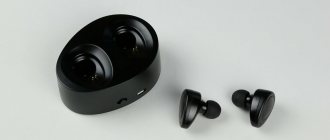The combination of a hype theme and the “Xiaomi” inscription attracts the attention of even those who are far from gadgets. So the “AirPods killer” was very warmly received by users.
Completely wireless headphones for only a thousand rubles are needed even by those who do not use them at all. Perhaps, after Apple, no one else has made such a contribution to their popularity.
But can AirDots somehow compete with AirPods? Or is this just another Chinese thing with a famous logo, meaningless and merciless?
Redmi or Xiaomi? How not to make a mistake
It’s worth starting with the fact that under the “AirDots” logo you can find at least 3 options in 2 colors with different capabilities.
Exist:
- white Xiaomi Mi AirDots with touch buttons
- black Redmi AirDots and Mi True Wireless Earbuds Basic with mechanical buttons
The former turned out to be a first for Xiaomi in the niche of completely wireless headphones ( TWS ). Cheap, simple. To make them more accessible (twice), an option with “clicking” mechanical buttons has appeared.
The second and third in black are the same thing, but for different markets: Redmi for export, Xiaomi Mi for their own. The only differences are in the box and the inscriptions on it.
Except for minor issues, all three are the same headphones. NFC and touch panels don't always justify their existence. And they certainly don’t justify the twofold difference in price.
Another interesting thing: Redmi AirDots are the most affordable TWS headphones with the price of a rootless noname - on sales they can be found for 800 rubles.
"Mi Bend" in my ears number 2
Xiaomi engineers did not reinvent the wheel, and used the housing of an updated version of their old Bluetooth headphones with wiring for AirDots: Mi Bluetooth Mini .
If anyone hasn’t guessed right, yes, these are scaled capsules of the first Mi Band. They clearly lack elegance. On the other hand, what to expect from an ultra-budget gadget?
The body is completely made of plastic. On the inside of each earphone there is a multi-polar magnet and a sound guide, on the reverse there is a control button for the entire cover.
The key travel is small and pleasant. Interestingly, volume or track controls don't work, so the options are modest even at this point in the review.
A long press is used to reject a call or switch the sound to the phone/headphones, a short press is to answer or end a call, and a double short press is to switch between interlocutors and turn the microphone on/off.
Splash protection class IPx4 , but it only applies to headphones. Even short-term exposure to jets will cause damage.
It's all about miniature: the requirement for comfort in constant wearing has led to the fact that each earphone weighs only 4.1 grams.
Each earbud has its own noise-canceling microphone. However, in public transport and on the streets of big cities, external sources will break into the conversation and disturb the interlocutor.
They work together, separately and with whatever you want
Each earbud in a pair of Redmi AirDots can operate independently. Interestingly, if you connect the left earphone , both will be connected; if the right one , you will need to connect the second one separately.
If you remove the earphone for more than 20 seconds, the second one will no longer connect. You will have to insert both into the charging case and do everything again.
No sensors: AirDots turn off after 5 minutes of inactivity or when connected to a charging base.
But there are no restrictions when connecting to sources. Although it uses low-cost Bluetooth 5.0 , AirDots work great even with older 2.0 dongles.
It is interesting that the new codec made it possible to achieve a direct operating range of 30 meters with a source. A pair of AirDots can be separated by 7 meters without breaking the connection.
The list of supported codecs, which is not at all surprising, includes only SBC and SBC XQ. You can’t even dream about AptX and AAC at this price point.
Indication
In addition to controlling the button (selecting frequencies, number of presses and holding duration), when working with Xiaomi Airdots, you can also be guided by the color of the headset indicators. They can be white or red. Flickering light means that the device is in progress (white - searching for connection, red - charging). No light means the headphones are turned off. If the light is white before turning off, it means the headset is fully charged. If it's red, it's completely discharged. Alternating red and white flashing indicates the reset procedure before connecting your Airdots again.
Case and everything, everything, everything
The case used to charge and store AirDots also fell victim to miniaturization: without them it weighs only 26 grams, with them - 34 grams.
In total, the set is not only invisible in the hand, it is easy to lose even in your own pocket!
Everything is made of plastic again: the outside of the case is matte with a soft-touch coating, the inside is glossy. Both are very easily soiled.
Strictly speaking, the headphones retain even the prints of dry, clean hands. To scratch a matte surface, a sheet of paper or a touch with a third-party hard object is sufficient.
Unchanged appearance of TWS rank and file
The second revision of AirDots received almost no external differences: the same lightweight body a la Mi Band made of solid plastic, LEDs for display, plastic case.
In fact, there are many differences. The main thing that catches your eye is that the case of the new AirDots 2 is angular, with sharp edges.
It is worth keeping in mind that the original headphones do not have a full logo engraving - the inscription is barely noticeable with the correct backlight. Otherwise, we have a fake.
The inscription on the reverse side can be dim or bright - it depends on the market for which the “ears” are intended, the month of issue and much more.
The only thing that definitely gives away a fake is if the letters protrude, as if they were welded on.
The solution with the display is no less surprising: the case itself did not receive any elements, so the headphones use bright dots.
When charging they glow red, and when connected for the first time they blink in the same color. System reminders notify the owner with a white light.
For charging, AirDots 2 received USB-C instead of microUSB of earlier modifications of the headphones. The corresponding cable is included.
This solution is perhaps the most important: now the smartphone and accessories can finally be charged with one wire.
How long does it last without charging?
Inside the case there is a pair of magnetic slots for headphones and a 300 mAh . Each earphone has another 40 mAh.
This is enough for 3-4 hours at a volume of 40-60%, after which you will have to return the headphones to the carrying case for an hour and a half. Total in total - up to 14-16 hours. Not much, because in the cold this figure is reduced by almost 30%.
The case itself charges for at least 2 hours using a standard microUSB cable and any suitable wire. By the way, there is no cable included.
Contents of delivery
The device is available in two colors: black and white.
The package includes:
- a plastic capsule that acts as a charger;
- the headphones themselves, which are located in the capsule;
- replaceable ear pads (attachments) of different sizes;
- documentation.
The manufacturer did not include a micro USB cable in the package: it must be purchased separately, but it is not necessary; a cable from a smartphone with an appropriate connector will do.
What is inside?
According to the tradition of the genre, Redmi/Xiaomi/1More engineers did everything possible and tried to stretch the sound of cheap headphones to an acceptable level.
They managed to install 7.2 mm speakers instead of the usual 6 mm ones in TWS, and achieve a sensitivity of 93 dB ± 3 dB , which is not so bad for the reproduced frequency range of 20-20000 Hz.
At least better than in noname. Realtek RTL8763BFR chip promises decent (for headphones without aptX and AAC) sound quality. But the absence of a published frequency response should immediately suggest
Counterfeits: is there a chance of getting caught?
Completely worn out. Or it could be worse if you buy a fake
As a result, blue boxes are currently produced under the Xiaomi logo for the European market, and red boxes with the Redmi logo are produced for the Chinese market. Both can be obtained on AliExpress.
The differences between the Chinese version and the European version are only in the text on the box and the accompanying documentation: the European version even has Russian.
The combination of Redmi and blue box is currently not found in the original variants
Today, only the Mi variant is available for the European market, and Redmi for the Chinese market. Otherwise, it should lead to thoughts of a fake, which will be even worse.
The second generation and modification S received a serial number on the air duct, by which you can check the originality using the link indicated on the box.
They are available in the same colors as the first generation.
A few words about sound
Redmi AirDots don't sound bad at all. After a couple of days you get used to it, and you don’t seem to need anything more. But only until you hear normal “ears”.
The entire reproduced range plays without defects, although there is an overestimation of the upper ones. It can be easily corrected with an equalizer. There is not much bass, and bassheads will not like it: clear, dry.
The scene is compressed, the sound is dry and moderately detailed, equalized for the video sequence. So that the voice and the filled-in podcast are as legible as possible.
Otherwise, the younger AirDots sound no worse than the protected sports Xiaomi Mi Bluetooth and other analogues. And better than other TWS in the price range up to 3 thousand rubles.
Simply because in fact they are the same thing. Only Redmi has any kind of quality control and decent components.
Sound quality
Moving on to the most interesting question, it is worth recalling that we are talking about budget headphones, so the requirements for them must be met accordingly. In terms of quality, Redmi headphones have an obvious advantage. They handle the bass well without drowning out the mids and highs.
7 mm drivers installed in Redmi AirDots provide high-quality sound in any musical genre. Some troubles may appear at the maximum volume level, but in reality you don’t have to deal with such things if you take care of your own hearing.
Xiaomi AirDots perform well for headphones in this price segment. The sound is broadcast quite clear, but without frills.
Both devices can act as a headset. As with listening, DPS is used for noise reduction. Thanks to this, you can talk with your interlocutors without any problems.
Weekend with AirDots
On the other hand, Redmi AirDots are a simple and reliable way to try completely wireless headphones as a class, and decide whether you really need them.
The lack of touch panels is surprisingly convenient. This provides better touch control and eliminates the phantom clicks that often occur with any headphones with gesture or touch controls.
The controls are clear enough to quickly learn combinations. But they don’t work with some Android smartphones, and the ears themselves lose connection every once in a while. Moreover, there is no pattern in this.
If they made money right away, it means they will continue to work. Otherwise, you can clear the cache, change the firmware, connect them to the source several times... And everything will work. But it’s unpleasant, creepy.
The fit is quite deep , which, with the right choice of ear pads, provides good noise insulation. At 70% volume you can no longer hear the metro, 50% is enough for a busy street.
Even the mode of use turns out to be quite expected: inserted an earphone, listened, talked, inserted another one. I thought about it and used the stereo. Easy and convenient, and everything is like a clock.
Appearance Features
The new product is traditionally made of plastic, but this time it was decided to use two types of material at once: the inside of the device is made of matte plastic, and the outside is made of glossy. On the one hand, this solution looks interesting due to the difference in textures. On the other hand, the glossy surface easily leaves traces from hand touches and, accordingly, the case looks a little unesthetically pleasing.
The weight of Redmi AirDots 3 is 4.6 grams, and thanks to the improved shape, the design fits perfectly into the ear. The headphones “sit” steadily even with active head tilts, which makes them an excellent solution for sports. Optimization of the air ducts has reduced the pressure on the inside of the ear, so there is no feeling of discomfort even after long-term wearing.
There is an LED on the front surface of the device. It lights up when the device is in working condition. A controversial solution is to install a touch area to control the device, as it increases the likelihood of accidental operations. What helps minimize it a little is that to start or pause a song you need to double-click on the right earbud. True, sometimes you have to do this several times in a row, which is not very convenient. If you double-click on the left headset, the voice assistant is activated.
If you buy Xiaomi Redmi AirDots 3, you won’t have to worry that they will malfunction due to sweat or rain. Their housing is protected from moisture according to the IPX4 standard, which, however, does not imply the possibility of complete immersion under water.
The case, which is made entirely of matte plastic with a pleasant-to-touch texture, also looks impressive. A charging indicator has appeared: it blinks when the device is charging, and lights up constantly when the charge level is already replenished.
To connect to the network, use a USB Type-C cable, which is included in the kit. The box lid opens softly, and a high-quality magnetic system is used to close it. In the central part there is a factory reset button.
In general, there are no questions about the build quality of the new product: it is assembled decently, does not play or creak during use. Redmi AirDots 3 wireless headphones are offered in three colors: white, pink and dark blue.











